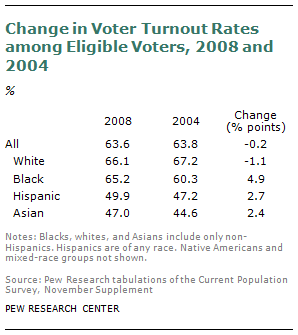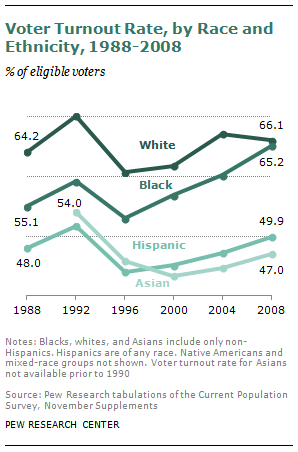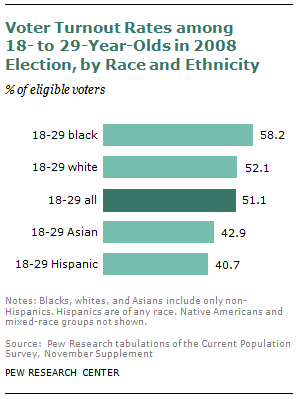The Growing Electoral Clout of Blacks Is Driven by Turnout, Not Demographics
Paul Turner, Pew Research Center, Dec. 26, 2012
Blacks voted at a higher rate this year than other minority groups and for the first time in history may also have voted at a higher rate than whites, according to a Pew Research Center analysis of census data, election day exit poll data and vote totals from selected cities and counties.
Unlike other minority groups whose increasing electoral muscle has been driven mainly by population growth, blacks’ rising share of the vote in the past four presidential elections has been the result of rising turnout rates.
{snip}
In fact, according to census data and the election day exit polls, blacks made up 12 percent of the eligible electorate1 this year but accounted for an estimated 13 percent of all votes cast — a repeat of the 2008 presidential election, when blacks “over-performed” at the polls by the same ratio. In all previous presidential elections for which there are reliable data, blacks had accounted for a smaller share of votes than eligible voters.
The candidacy in 2008 and 2012 of Barack Obama, the nation’s first black president, is no doubt one of the main reasons for these new patterns.
{snip}
In 2012, more Hispanics and Asian-Americans voted than ever before, but the turnout rates among these groups (votes cast as a share of eligible voters), while rising, continues to lag that of the general public by a substantial margin. Their growing electoral muscle is mainly due to their rapid population growth.
As for whites, not only has their share of the eligible electorate been falling for decades, but their turnout rate appears to have declined in 2012 for the second presidential election in row.2
Did the turnout rate of blacks exceed that of whites this year for the first time ever? For now, there’s circumstantial evidence but no conclusive proof. And there’ll be no clear verdict until next spring, when the U.S. Census Bureau publishes findings from its biannual post-election survey on voter turnout.
{snip}
Overall, about 129 million votes were cast for president in 2012, down slightly from 131 million in 2008. When one factors in a 9 million increase in the age and citizen eligible electorate due to normal population growth between those two elections, the turnout rate among all eligible voters fell by more than 3 percentage points — to about 60% in 2012 from more than 63% in 2008.
{snip}
The post-election survey also showed that in 2008, young blacks (18 to 29 year olds) voted at a higher rate than young whites (58% versus 52%) – a difference that was almost certainly related to the historic nature of the Obama candidacy.
{snip}
The political importance of turnout rates by race was brought into sharp focus by last month’s election, in which Obama won 80% of the non-white vote (including 93% of blacks, 73% of Asian Americans and 71% of Hispanics) and just 39% of the white vote.
{snip}
For comparative purposes, consider the 1988 presidential race between GOP nominee George H.W. Bush and Democrat Michael Dukakis. Bush received the identical share of the white vote that GOP nominee Mitt Romney won this year – 59%. But 24 years ago, that share was good enough to give Bush a popular vote margin of 7 million and an Electoral College landslide of 426-111.
{snip}

















